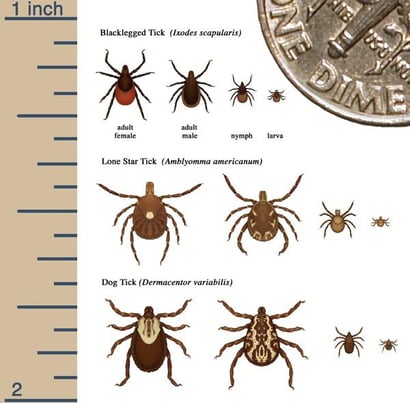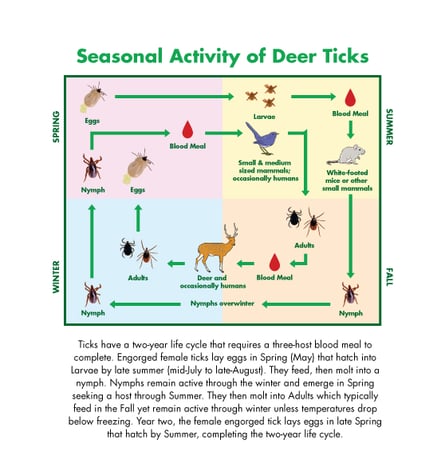About Lyme Disease
GLA Funded Research
Apply for Funding
Ticks are small crawling bugs that have eight legs and are related to spiders and mites. They are arachnids, not insects. Ticks are parasites that feed on the blood of humans and animals to survive. They are called vectors (carriers) because they can feed on a Lyme disease-infected animal (such as a mouse), then carry and transmit the Lyme bacterium Borrelia burgdorferi to the next animal or person they bite.
 Which Ticks Carry Lyme Disease?
Which Ticks Carry Lyme Disease?There are hundreds of different kinds of ticks throughout the world. The Ixodes tick, commonly called a black-legged tick, are ticks that carry Lyme disease. In the east and upper midwest regions of the United States, the primary tick species is Ixodes scapularis (or deer tick) and the related western U.S. version is the Ixodes pacificus (western black-legged tick).
These ticks that carry Lyme disease can also carry bacterial co-infections, such as Babesiosis, Ehrlichiosis, and Anaplasmosis. While Lyme disease is the most common infection from a tick, co-infections can complicate one’s Lyme disease diagnosis and treatment. Learn more about ticks and the other diseases they can cause in the U.S.
Ticks that carry Lyme disease are active year-round and can survive in below-freezing temperatures, although their peak season of activity begins in the warmer weather months of April through September. During this time, the hungry nymphal tick (about as small as a poppy seed) actively seeks a host, and its bite poses the greatest risk.
Learn more about how climate change is affecting the behavior of ticks.
Ticks generally live two to three years and have a four-stage life cycle. The four stages of their life cycle include egg, larva, nymph, and adult.
 TICK LARVA: The tick larva is about the size of the period at the end of this sentence. They are almost impossible to find on your body but have not been proven to transmit tick-borne illness.
TICK LARVA: The tick larva is about the size of the period at the end of this sentence. They are almost impossible to find on your body but have not been proven to transmit tick-borne illness.
TICK NYMPH: The nymph is the size of a poppy seed. Nymphal ticks cause the majority of Lyme disease infections in people. Because of their very small size and painless bite, these ticks are generally not detected. Nymphs are most active in the late spring and summer months.
ADULT TICKS: Adult ticks are roughly the size of a sesame seed. Due to their small size and flat shape, they can be difficult to find on your body. Adult ticks that carry Lyme disease feed and mate primarily on deer. You may also find adult ticks on dogs, horses, and domesticated animals.
Infected ticks can be found anywhere their hosts live, in short, anywhere in the world. They prefer moist, shady, often wooded areas. The phrase “deer tick,” the name commonly used for the species of ticks that carry Lyme disease, is somewhat of a misnomer. Although deer are important as reproductive hosts in the lifecycle of these ticks, other vertebrate animals actually infect the ticks with disease organisms — not the deer. These animals include white-footed mice, chipmunks, shrews, several species of ground-feeding birds (American robin, finches, wrens, bluejays, etc.), and many other small mammals. Lyme disease ticks can be found in:
You can keep yourself, your loved ones, and your pets from encountering Lyme ticks with a few easy, Be Tick AWARE prevention steps:
Learn more about preventing encounters with ticks that carry Lyme disease on our prevention page.
2023 © Copyright Global Lyme Alliance. All rights reserved.
Disclaimer: The above material is provided for information purposes only. The material (a) is not nor should be considered, or used as a substitute for, medical advice, diagnosis, or treatment, nor (b) does it necessarily represent endorsement by or an official position of Global Lyme Alliance, Inc. or any of its directors, officers, advisors or volunteers. Advice on the testing, treatment or care of an individual patient should be obtained through consultation with a physician who has examined that patient or is familiar with that patient’s medical history. Global Lyme Alliance, Inc. makes no warranties of any kind regarding this Website, including as to the accuracy, completeness, currency or reliability of any information contained herein, and all such warranties are expressly disclaimed.